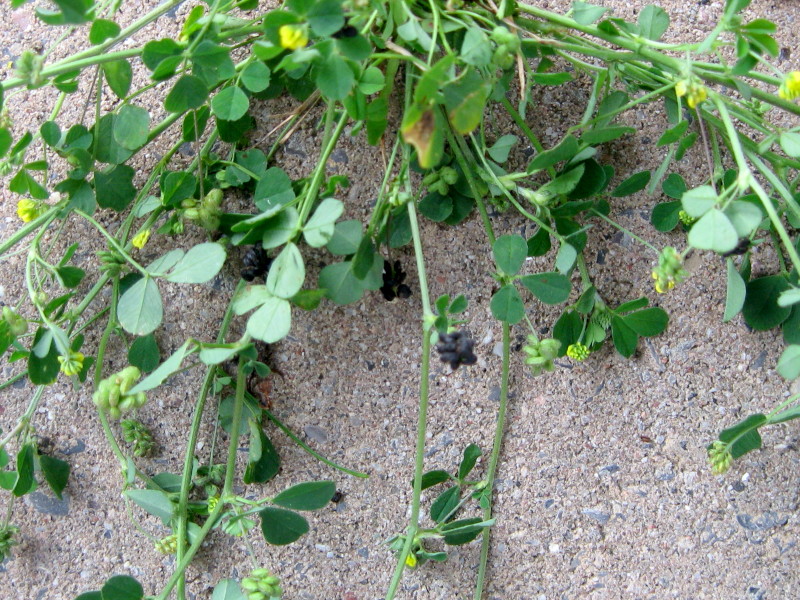Wise Mind Herbs
Evidence-based Herbal Healing
The information on this page has been prepared with reference to published scientific literature, not by a medically qualified expert. It is not medical advice. Any decision to use a supplement or herb-based product is your responsibility. Consult a suitably qualified medical professional, especially if you have underlying conditions. Remember, nothing is for everyone, and not everything sold is what it claims to be. Some things work for some people, some of the time.
Black Medick (Medicago lupulina)
Black medick (Medicago lupulina L.), also known as black medic, yellow trefoil, nonesuch, or hop medick, is a plant in the Fabaceae family. It should not be confused with yellow sweet clover (Melilotus officinalis), common melilot (Melilotus officinalis), or black mustard (Brassica nigra), though these plants are sometimes mistakenly identified as black medick due to similar yellow flowers or appearance.

Image source and license: https://commons.wikimedia.org/wiki/File:Medicago_lupulina.jpg.
Modified by Peter Jorgensen.
Scientific Evidence and Health Benefits
Research on black medick's medicinal properties is relatively limited compared to more extensively studied medicinal plants. The available scientific literature indicates some potential therapeutic applications, though most studies are preliminary and conducted in vitro or in animal models rather than through robust clinical trials in humans.
Black medick contains several bioactive compounds including flavonoids, phenolic acids, saponins, and tannins that may contribute to its potential health benefits. The plant also contains isoflavones similar to those found in other legumes, which have been studied for their antioxidant and anti-inflammatory properties.
Conditions Potentially Alleviated
- Inflammation: In vitro studies suggest anti-inflammatory properties due to flavonoid content.
- Oxidative stress: Extracts have demonstrated antioxidant activity in laboratory studies, potentially offering protection against free radical damage.
- Mild digestive issues: Traditional uses include relief of minor digestive complaints, though clinical evidence is lacking.
- Antimicrobial activity: Some laboratory studies indicate modest antimicrobial properties against certain bacteria.
Dosage and Standardization
Currently, there are no established clinical guidelines for black medick dosages due to insufficient human clinical trials. Traditional preparations have included:
- Dried herb: 1-3 g as a tea, up to three times daily
- Tincture (1:5 in 45% alcohol): 2-4 mL, up to three times daily
There is no standardization of active compounds in commercially available preparations, which presents challenges for consistent therapeutic applications. The content of bioactive compounds can vary significantly based on growing conditions, harvest time, and processing methods.
Side Effects and Disbenefits
- Generally recognized as safe when consumed in food amounts, but medicinal quantities have not been thoroughly evaluated for safety.
- May cause allergic reactions in individuals with sensitivity to plants in the Fabaceae family.
- Potential for mild gastrointestinal discomfort when consumed in large amounts.
- Contains coumarin derivatives in small amounts, which theoretically could interact with anticoagulant medications, though documented cases are lacking.
- Not recommended during pregnancy or lactation due to insufficient safety data.
High-Dose Studies
There is a significant knowledge gap regarding high-dose applications of black medick. No systematic studies have investigated doses above the traditionally used ranges mentioned above. Consequently, the safety profile, potential toxicity, or additional therapeutic benefits of higher doses remain unknown. This represents an important area for future research.
Pharmaceutical Products
Currently, there are no approved pharmaceutical medications that contain black medick extract as a primary or secondary ingredient. Unlike more extensively studied medicinal plants such as St. John's wort or ginkgo biloba, black medick has not been developed into standardized pharmaceutical preparations. It is occasionally included in herbal combination products marketed as dietary supplements, but these are not regulated as pharmaceuticals and do not make specific treatment claims.
Research Limitations
The current body of research on black medick has several limitations:
- Most studies are preliminary, with few randomized controlled trials in humans.
- Variations in extract preparation methods make comparisons between studies difficult.
- Research has primarily focused on in vitro effects rather than clinical outcomes.
- No comprehensive toxicology studies are available.
Conclusion
While traditional uses and preliminary research suggest potential health benefits of black medick, the scientific evidence remains insufficient to make definitive claims about its efficacy for specific health conditions. More robust clinical trials are needed to establish effective dosages, standardization requirements, and safety profiles. Individuals interested in using black medick for medicinal purposes should consult healthcare providers, particularly if taking other medications or having underlying health conditions.
References
Bakhtiar, Z., Hassandokht, M., Fozi, V., & Mirjalili, M. H. (2025). Agro-morphological yield-attributed traits, essential oil content, phytochemical composition, and biological activities of some Medicago species. Chemical and Biological Technologies in Agriculture, 12(1), 25.
Butkutė, B., Padarauskas, A., Cesevičienė, J., Pavilonis, A., Taujenis, L., & Lemežienė, N. (2017). Perennial legumes as a source of ingredients for healthy food: proximate, mineral and phytoestrogen composition and antibacterial activity. Journal of Food Science and Technology, 54, 2661-2669.
Jakupović, L., Kalvarešin, M., Bukovina, K., Poljak, V., Vujić, L., & Zovko Končić, M. (2021). Optimization of two eco-friendly extractions of black medick (Medicago lupulina L.) phenols and their antioxidant, cosmeceutical, α-glucosidase and α-amylase inhibitory properties. Molecules, 26(6), 1610.
Khairy, A., Hammoda, H. M., Metwally, A. M., Zaatout, H. H., & Ibrahim, R. S. (2025). Therapeutic potential of Medicago sativa (Alfalfa): A comprehensive review of its bioactive compounds and pharmacological properties. Journal of Advanced Pharmaceutical Sciences, 1-27.
Prostodusheva, T. V., Kiselevskii, M. V., Bokov, D. O., Zaichikova, S. G., Antsyshkina, A. M., Bobkova, N. V., ... & Shalburova, S. G. S. (2024). The Black Medick (Medicago lupulina L.) extraction Cytotoxic activity. Research Journal of Pharmacy and Technology, 17(10), 4658-4662.